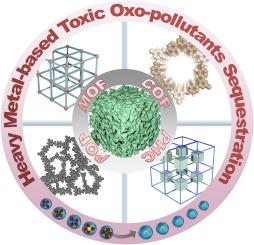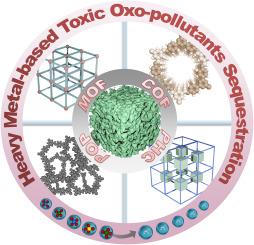金属有机框架(MOFs)及相关的其他先进多孔材料用于封存水中的重金属有毒氧化污染物
IF 20.3
1区 化学
Q1 CHEMISTRY, INORGANIC & NUCLEAR
引用次数: 0
摘要
近年来,环境污染及其影响已引起全世界的关注。在此背景下,水污染被认为是近年来各类污染中对所有生物构成的最大威胁之一,如果不尽快采取补救措施,预计情况会变得更糟。随着世界上越来越多的地区遭遇水危机,水循环利用在二十一世纪变得越来越重要。有鉴于此,CrO42-、Cr2O72-、AsO43-、SeO32-、SeO42-、TcO4-、ReO4- 等重金属有毒氧化污染物对地下水的污染已迅速成为全球关注的焦点,并对人类健康和环境构成了重大风险。由于这些有害的持久性化学物质在生物累积后具有极强的毒性,已被美国环境保护局(EPA)指定为优先污染物。因此,以有效的方式将它们从受污染的水中去除至关重要。在这方面,由于金属有机框架 (MOF)、多孔有机聚合物 (POP)、共价有机框架 (COF) 和多孔杂化复合材料等先进功能多孔材料 (AFPM) 与传统吸附剂相比具有孔隙率可调、比表面积高和功能基团丰富等优势,如今已引起废水处理研究人员的极大关注。本综述概述了先进功能多孔材料(包括 MOFs 和相关多孔材料)的最新进展,这些材料可用作有效的吸附剂,去除受污染水体中重金属产生的有害氧阴离子。此外,该综述还提出了确保饮用水安全和清洁的实用解决方案。此外,还讨论了它们的吸附机理,这有助于更好地设计基于 MOFs/AFPMs 的性能优越的新型吸附剂,供今后研究使用,同时也有助于了解 MOFs/AFPMs 与重金属氧杂环污染物之间的吸附过程。最后,为了充分了解未来的发展前景,还深入讨论了 MOFs/AFPMs 的潜力和挑战。本文章由计算机程序翻译,如有差异,请以英文原文为准。


Metal-organic frameworks (MOFs) and related other advanced porous materials for sequestration of heavy metal-based toxic oxo-pollutants from water
In recent years, environmental pollution and its effects have demanded attention from all over the world. In this context, water pollution has been regarded as one of the biggest threats to all living forms among all types of pollution in recent years, and things are forecasted to get worse if remediating steps are not adopted soon. Water recycling has gained importance in the twenty-first century as more areas of the world experience a water crisis. Given this, ground-water pollution by heavy metal-based toxic oxo-pollutants such as CrO42−, Cr2O72−, AsO43−, SeO32−, SeO42−, TcO4−, ReO4− etc. have been becoming rapidly growing global concerns and pose a major risk to both human health and the environment. These hazardous and persistent chemicals have been designated as priority pollutants by the US Environmental Protection Agency (EPA) due to their extreme toxicity following bioaccumulation. Therefore, it is crucial to get rid of them from contaminated water in an efficient manner. In this regard, now a days, Advanced Functional Porous Materials (AFPMs) such as metal-organic frameworks (MOFs), porous organic polymers (POPs), covalent organic frameworks (COFs), and porous hybrid composite have drawn significant attention from researchers looking into wastewater treatment owing to their advantages of tunable porosity, high surface area, and an abundance of functional groups over traditional adsorbents. This review provides an overview of the latest advancements in Advanced Functional Porous Materials, including MOFs and related porous materials, used as effective adsorbents to remove harmful oxoanions derived from heavy metals from contaminated water. Additionally, the review suggests practical solutions for ensuring the safety and cleanliness of drinking water. Furthermore, their adsorption mechanisms are discussed which may enable better designing of new MOFs/AFPMs-based adsorbents with superior performance for future study as well as for understanding the adsorption process between MOFs/AFPMs and heavy metal oxoanions contaminants. Lastly, in order to fully comprehend the developing prospects for the future, the potential and challenges of MOFs/AFPMs were thoroughly discussed.
求助全文
通过发布文献求助,成功后即可免费获取论文全文。
去求助
来源期刊

Coordination Chemistry Reviews
化学-无机化学与核化学
CiteScore
34.30
自引率
5.30%
发文量
457
审稿时长
54 days
期刊介绍:
Coordination Chemistry Reviews offers rapid publication of review articles on current and significant topics in coordination chemistry, encompassing organometallic, supramolecular, theoretical, and bioinorganic chemistry. It also covers catalysis, materials chemistry, and metal-organic frameworks from a coordination chemistry perspective. Reviews summarize recent developments or discuss specific techniques, welcoming contributions from both established and emerging researchers.
The journal releases special issues on timely subjects, including those featuring contributions from specific regions or conferences. Occasional full-length book articles are also featured. Additionally, special volumes cover annual reviews of main group chemistry, transition metal group chemistry, and organometallic chemistry. These comprehensive reviews are vital resources for those engaged in coordination chemistry, further establishing Coordination Chemistry Reviews as a hub for insightful surveys in inorganic and physical inorganic chemistry.
 求助内容:
求助内容: 应助结果提醒方式:
应助结果提醒方式:


